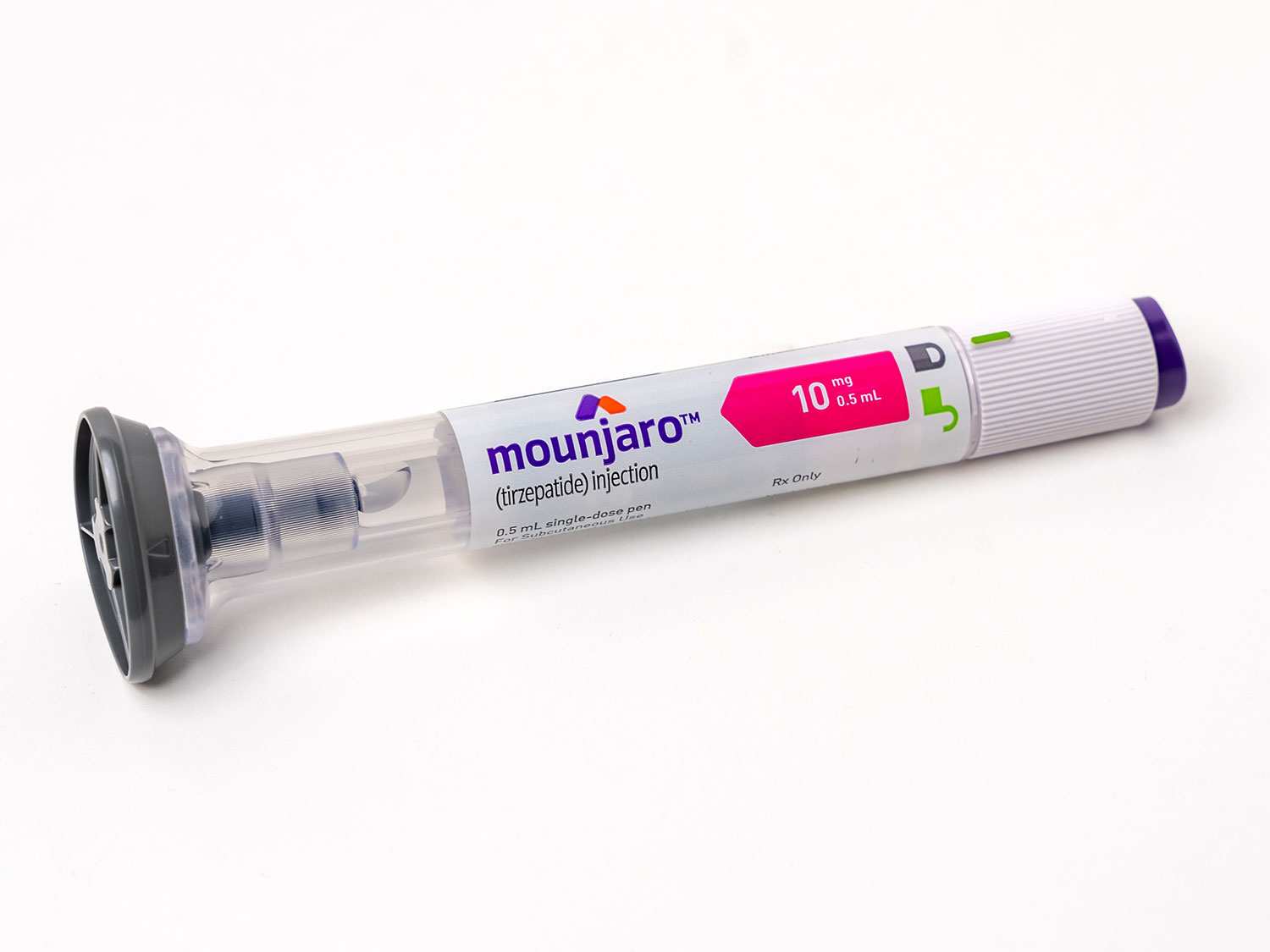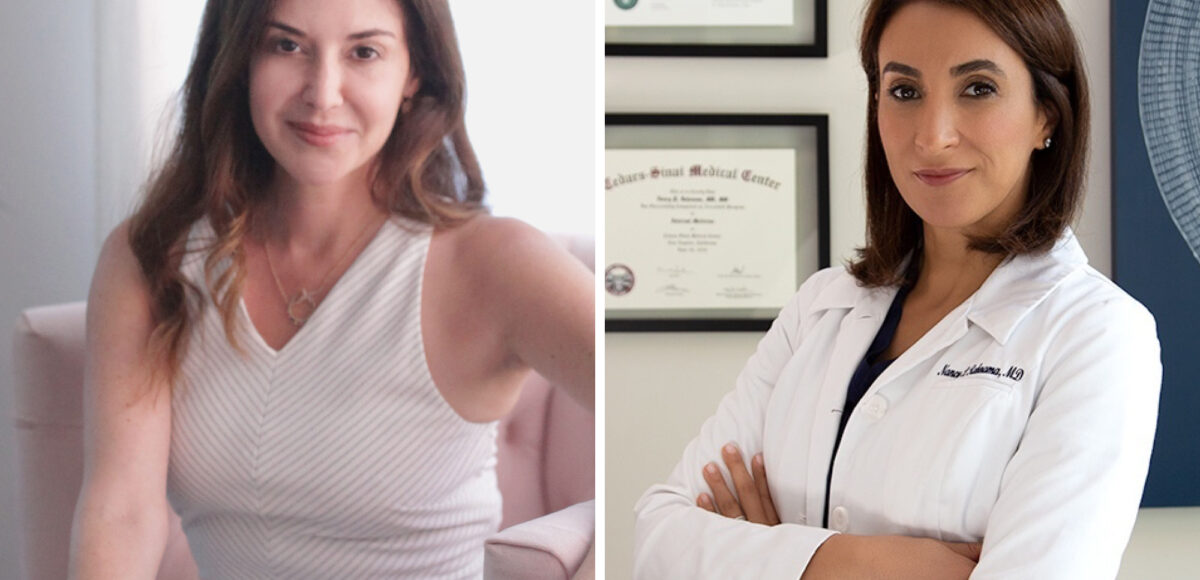Doesn’t it seem these days that we all know someone (or someone who knows someone) who is on Ozempic or any number of its cousins? Or, we’ve listened with a raised eyebrow to those people who have dramatically lost weight, seemingly overnight, claim they aren’t on the weight loss drug and simply changed their diet and started exercising. Then, there are the celebrities who plaster social media with selfies showing off their impossibly reduced waistlines and swear it’s not Ozempic. Last year, when Kim Kardashian lost 16 pounds in three weeks to fit into a dress worn by Marilyn Monroe for the Met Gala, she said she owed her new silhouette to daily runs and a sauna suit.
As the world looks to Beverly Hills to set beauty trends, two prominent and highly respected Beverly Hills-based doctors, Dr. Nancy Rahnama and Dr. Suzanne Wallach, are working to set the record straight, and leading the charge in influencing the conversation around Ozempic and semaglutide.
Rahnama is an internist and board-certified obesity medicine specialist, practicing bariatric medicine with a weight loss clinic on Bedford Drive. She earned her medical degree from the University of Southern California, with an internal medical residency at Cedars-Sinai and completed her training with a fellowship at the University of California Los Angeles to earn a subspecialty in clinical nutrition.
Armed with nearly a decade of experience with weight loss drugs specifically, Rahnama has appeared on television news programs, such as NBC’s “Today” show, and in print for newspapers including the Wall Street Journal to spread her message. It is quite simple: if you are taking Ozempic and you’re not a diabetic, obese or medically overweight, you are likely doing yourself more harm than you realize.
According to Rahnama, “Most people taking Ozempic who do not fall under the FDA requirements for the drug, meaning they don’t have type 2 diabetes, or a body mass index (BMI) greater than 30 or a BMI greater than 27 with a comorbidity like high blood pressure, high cholesterol or diabetes are abusing the drug.”
Abuse sounds like a strong word, but she said she feels strongly, “We need to start calling it what it is—‘abuse’ in order to differentiate between those who actually need the drug and those who don’t.”
And for her, the distinction needs to be made, not just because of the shortage of Ozempic, which made headlines last year when it was exposed that millions of Americans who did not qualify for it were taking the drug, eating up the supply meant for diabetics. “People who are abusing [it] are far more likely to develop the serious side effects we’re hearing about in the news,” she said. The dangerous physical side effects that have been reported, so far, range from intestinal blockages to stomach paralysis.
The U.S. Food and Drug Administration (FDA) approved Ozempic, a brand name semaglutide, for patients with type 2 diabetes back in 2017. Semaglutide, a synthetic form of a naturally occurring hormone called glucagon-like peptide-1 (GLP-1), assists the body in making more insulin, which lowers blood sugar levels for people with diabetes. But early trials showed the drug led to significant weight loss, because it also slows down the emptying of the stomach, causing people taking it to feel full faster and eat less. The results were so dramatic that the pursuit of bringing a semaglutide for weight loss specifically kicked into high gear.
In June 2021, the FDA approved a semaglutide for obese and overweight patients with at least one weight-related condition (such as high blood pressure, type 2 diabetes, or high cholesterol) under the brand name Wegovy.
Last year, the FDA approved Mounjaro, a combination of GLP-1 and GIP (gastric inhibitory peptide). While approval of the drug for weight loss use is pending with the agency, many doctors commonly prescribe it off-label for their overweight patients.

Photo by nataliagh/depositphotos.com
Rahnama explained that while GLP-1 medications have been around for 15 years in one form or another and many such as Trulicity are prescribed by doctors today, many physicians still don’t know how to prescribe it, and they don’t follow up with patients afterward.
“Many doctors, like your average primary care physician, haven’t been educated on how to administer the drug. They don’t know what the appropriate dosages are. They lack a deeper understanding of nutrition and don’t properly monitor patients after they begin taking it,” she said.
When doctors prescribe Ozempic to people who don’t fit the FDA criteria for the drug, they often get the dosage wrong because the pharmaceutical guidelines they would normally rely on don’t apply. It becomes trial and error. According to Rahnama, the wrong dosage can lead to gastrointestinal issues, which can be so severe they require hospitalization.
If a doctor is administering Ozempic and sending you on your way, you may be unaware of the potential risks from the lack of follow-up. There are several reasons why checking in with patients taking Ozempic is crucial. For one, whenever you lose weight, not all of it comes from fat; you actually lose some muscle and bone mass. Ozempic speeds up that process and is especially of concern in older patients where bone density is already an issue. According to a study done by the New England Journal of Medicine, when researchers looked at a subgroup of 140 participants who fit the FDA criteria for taking Ozempic, they found on average, participants lost about 15 pounds of lean muscle during the 68-week trial. The mean age of participants in that study was 52.
At Rahnama’s clinic, patients are required to get their body composition checked to be sure that the weight they are losing is fat and not bone or muscle. They are also required to have lab work done every week or every other week to see whether any other
medications the patient is taking should be tapered off.
As you lose significant amounts of weight, your blood pressure or cholesterol might go down, so the medications taken to control those issues should also be reduced. Rahnama wants to catch this and course correct along the way. “Most doctors don’t know how to do this monitoring. I don’t prescribe the drug unless the patient has committed to a three- to four-month treatment plan while they’re using the drug,” she said.
Despite the headlines, many are undaunted in their pursuit of a slimmer figure. “I can’t believe some of the requests I see,” Rahnama said. “And there have been a few times where I’ve seen a patient and said, ‘No,’ and they’ve gotten quite upset. I’ve explained to them how taking the medication could only cause more harm than benefit because they don’t have any weight to lose!” Often, they leave angry and search for a doctor who will give them Ozempic.
It’s something Dr. Suzanne Wallach is all too familiar with, and she wants this to change.
Wallach is a licensed marriage and family therapist and the owner and Clinical Director of Suzanne Wallach & Associates and SoCal DBT. She received her bachelor’s degree in psychology from Ottawa University, her master’s degree in clinical psychology from Phillips Graduate University and her doctorate in psychology from The Chicago School of Professional Psychology. She specializes in personality disorders, with a subset that covers eating disorders, substance abuse and trauma.
While she has notably been featured in the press in her native Canada and has weighed in as an expert across a wide variety of mental health issues, Ozempic is a relatively new issue. And it’s one most don’t immediately connect with mental health. However, as a therapist, she is privy to the secrets many of her clients wouldn’t share with their best friend—like taking Ozempic. She has begun to speak out publicly about the psychological fallout she is witnessing firsthand from the obsession with the weight loss drug.
“My practice is in the middle of Beverly Hills and half of my clients, none who need it, are on Ozempic,” said Wallach. “It’s to the point where I almost don’t know anyone who isn’t on it. All my friends are on it, therapists on staff here are on it. I went to see my doctor, who is based in Beverly Hills about hormone replacement therapy, and he asked me if I wanted Ozempic. And I weigh 105 pounds.”

Photo by mauricenorbert/depositphotos.com
So how is everyone getting their Ozempic?
“It’s just so incredibly easy to get it here,” said Wallach. “My Beverly Hills clients, again these are not overweight people, tell me they get it from their doctors, who are also in Beverly Hills. I had a client who, when she couldn’t find Ozempic in California, had her doctor fill the prescription for it in Arizona, and then she had a family member ship it back to her in Beverly Hills.”
Some clients have turned to the internet to purchase it online from compounding pharmacies or they get compounds administered at med spas. Compounds, semaglutide cut with various other additives, are not FDA approved and the agency warns against using them.
Because they’re unregulated, you have no idea exactly what you’re injecting into your body.
“What I’ve really noticed with my clients is that their doctors don’t take them off of Ozempic, and they’re terrified to go off of it because they don’t want to gain the weight back,” said Wallach. “It’s fueling body dysmorphia and leading to eating disorders. I had a client come in and say, ‘I only had two pieces of edamame yesterday. It was great!’ And I’m telling them, ‘You can’t survive on two pieces of edamame. That’s not okay. If you weren’t on Ozempic, I would be sending you to treatment for an eating disorder!’”
Wallach warns of the effect not eating has on the brain, “When you’re not eating, whether willfully in the case of anorexics, or simply because you’re not hungry because you’re on Ozempic, you are starving your brain and it becomes malnourished. Your prefrontal cortex doesn’t work correctly so you can’t reason correctly, and then depression and impulsivity are more likely.”
However, the ease of acquiring Ozempic has led to unexpected and heartbreaking outcomes. “I have adolescent clients who don’t fit the criteria on Ozempic. One is 12 years old and the other is 14 and they don’t want to be on it. They tell me it makes them nauseous and sick, but they’re on it because their parents had an issue with their weight and put them on it. I remember when that happened, really pausing and thinking, this is really getting out of control.”
Wallach believes misuse of Ozempic is only going to get worse. “I think it’s a combination of the media, the celebrities who are so obviously on it, and add to that doctors that are willing to prescribe it to people that don’t need it. And when you have that combination, and it becomes so permeated and acceptable here that you have parents willing to put their children on it who don’t need it, I think it’s going to get worse,” she said.
On the other hand, Rahnama said she’s watched Ozempic transform the lives of her obese and overweight patients.

Photo by tanovak/depositphotos.com
Prior to these drugs, the treatment was simply diet and exercise. “This misconception has created a lot of frustration in people who have struggled with obesity, and it obviously has not solved the problem because obesity is now affecting almost 50% of Americans,” said Rahnama. “Many people don’t realize what overweight people have to struggle with their entire lives,” she said, before rattling off a list of problems that come with obesity, “sleep apnea and liver disease and having to take a slew of medications—blood pressure, cholesterol, diabetes, gout and joint pain.”
What’s more, Rahnama said these patients are prone to depression and anxiety and often lack the self-confidence to do many of the things most of us take for granted.
“I had one patient who, after several months of appropriate dosage and careful monitoring, lost a significant amount of weight. She came into my clinic all smiles; she told me she finally had the confidence to go on a dating app and she was giddy and blushing when she told me that she met someone special. She had never been on a date before.”
Another patient of Rahnama had wanted to pursue a new career, but he was terrified of even applying for jobs because he dreaded the in-person interview. After treatment, he had the confidence to go out on interviews and he reported back to Rahnama that he had scored his dream job.
While successes like these from adults are moving for Rahnama, the most touching changes come from her adolescent patients.
Obesity in children skyrocketed during the pandemic. And the numbers were staggering. According to the Centers for Disease Control and Prevention, “A study of 432,302 children, ages 2 to 19 years, found the rate of BMI increase nearly doubled during the COVID-19 pandemic compared to a pre-pandemic period.”
Early this year, the FDA approved semaglutide in patients 12 years or older with a BMI in the 95th percentile or higher for their age and sex. Rahnama says treating these patients is one of the most rewarding parts of her job.
“If you think about it, you can determine a child’s entire future by being able to help them control their weight at a young age,” she said. “Just imagine how limited their life might be because they’re struggling with obesity. Not only does it affect how they feel and how they function, but it also negatively impacts them emotionally. And that emotional impact causes trauma that can hinder them for the rest of their lives.”
“One of my young patients was finally able to go on a roller coaster that she wasn’t ever able to go on because of her weight, another was finally able to excel in tap dancing because she loved it but was limited by her weight. I think that’s a celebration in itself; you’re not just changing their bodies, you’re changing their lives.”







